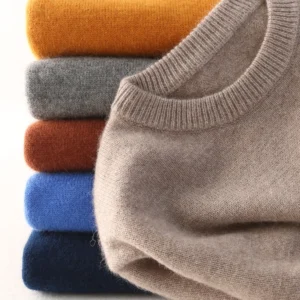Introduction to Cashmere: Nature’s Luxurious Gift
Cashmere stands as one of nature’s most exquisite offerings, a fiber so soft yet resilient that it has captivated humanity for centuries. Harvested from the undercoat of specific breeds of goats, particularly the Capra hircus, true cashmere is remarkably different from ordinary wool in both feel and function.
What makes cashmere truly extraordinary is its perfect balance of qualities: exceptional softness against the skin, impressive warmth despite its lightweight nature, and remarkable durability when properly cared for. In fact, cashmere provides up to six times more insulation than regular sheep’s wool while weighing significantly less – a testament to its remarkable natural engineering.
The limited supply further enhances cashmere’s luxury status. A single goat produces just 4-6 ounces of this precious fiber annually, requiring the harvest from 3-4 goats to create one sweater. This scarcity, combined with the challenging harvesting process, contributes to cashmere’s premium status in the textile world.
When selecting quality cashmere, understanding its geographic origin becomes essential. The harsh climates where cashmere goats thrive directly influence the fiber’s characteristics – from its diameter and length to its softness and durability. As you explore styling tips for cashmere cardigans, you’ll discover how these intrinsic qualities affect not just comfort but also appearance and longevity.
Throughout this guide, we’ll explore how different regions produce distinct cashmere qualities, the essential metrics that determine value, and practical techniques to identify truly premium offerings in a market where quality varies dramatically.
Understanding Essential Cashmere Quality Metrics
Before exploring geographic origins, it’s crucial to understand the fundamental measurements that determine cashmere quality. These metrics provide an objective framework for evaluating and comparing cashmere from different regions, helping you make informed decisions beyond marketing claims.
The quality of cashmere isn’t simply about where it comes from, but about specific, measurable characteristics that define its performance, feel, and longevity. Learning how to choose high-quality cashmere begins with understanding these key indicators:
Fiber Diameter: The Ultimate Measure of Softness
The diameter of individual cashmere fibers, measured in microns (μm), is perhaps the most critical determinant of quality and softness. This microscopic measurement has a profound impact on how the finished garment feels against your skin.
- Premium cashmere (Grade A): Under 15.5 microns – exceptionally soft with a silky feel
- Standard cashmere (Grade B): 16-19 microns – noticeably less soft but still comfortable
- Lower quality cashmere (Grade C): Over 19 microns – rougher feel, closer to fine wool
The geographic origin significantly impacts fiber diameter. For example, goats from extremely cold, high-altitude environments typically develop finer fibers for better insulation. This is why cashmere from certain Mongolian and Himalayan regions often features impressively low micron counts, resulting in the luxuriously soft feel found in brushed cashmere sweaters.
Fiber Length: Key to Durability and Reduced Pilling
While diameter determines softness, fiber length largely dictates durability and resistance to pilling (those small balls of fiber that can form on the surface with wear).
- Premium length: 36mm+ (1.4+ inches) – exceptional durability with minimal pilling
- Standard length: 28-34mm (1.1-1.3 inches) – good durability with moderate pilling resistance
- Lower quality: Under 28mm (1.1 inches) – prone to pilling and fiber shedding
Longer fibers can be twisted together more effectively during spinning, creating stronger yarns that maintain their integrity through wearing and washing. Regions with specific breeding programs and traditional harvesting methods often produce notably longer fibers.
Ply Count and Construction
The term “ply” refers to the number of yarn strands twisted together to create the final thread used in knitting or weaving cashmere garments.
- Single-ply: One strand of yarn, creating lightweight, less durable garments
- Two-ply: Two strands twisted together, offering balanced warmth and durability
- Multi-ply (3+): Multiple strands creating heavier, extremely warm, and durable garments
Different regions have developed unique approaches to ply construction based on local climate needs and traditional craftsmanship. Understanding cashmere ply thickness helps you select the right weight for specific uses – from lightweight spring scarves to heavy winter sweaters.
Color and Dyeing Considerations
The natural color spectrum of cashmere fibers varies by region and breeding, ranging from pure white to cream, tan, brown, and gray:
- White fibers are most versatile for dyeing into various colors
- Natural colors (undyed) often command premium prices for their authenticity
- Some regions produce goats with distinctive natural colorations
The dyeing process can affect fiber quality, with repeated processing potentially causing damage. This explains why naturally colored cashmere from certain regions is particularly valued for its combination of distinctive color and uncompromised fiber integrity.
Global Cashmere Production: A Geographic Quality Map
The world’s finest cashmere comes from specific regions where geography, climate, and tradition combine to create exceptional fibers. Understanding these regional differences helps explain the significant variations in quality and price found across cashmere sweaters and other luxury garments.
Each cashmere-producing region imparts distinct characteristics to the fiber based on a combination of environmental factors, goat breeds, and local harvesting and processing techniques:
| Geographic Origin | Typical Fiber Diameter | Average Fiber Length | Key Distinguishing Characteristics | Sustainability Notes |
|---|---|---|---|---|
| Mongolia (Outer) | 14-16 microns | 36-42mm | Exceptional softness, high durability | Growing sustainable herding initiatives |
| China (Inner Mongolia) | 15-18 microns | 32-38mm | Consistent quality, large-scale production | Varied sustainability practices |
| Himalayan (Kashmir/Ladakh) | 12-14 microns | 28-36mm | Extraordinary fineness, traditional processing | Limited production, heritage craft |
| Scotland | N/A (Processing) | N/A (Processing) | Superior finishing, resilient texture | Advanced water treatment systems |
| Italy | N/A (Processing) | N/A (Processing) | Sophisticated dyeing, innovative designs | Leading in sustainable manufacturing |
| Central Asia | 16-19 microns | 26-34mm | Varied quality, emerging improvements | Developing sustainability standards |
This geographic diversity explains why cashmere varies dramatically in quality and price. In the following sections, we’ll explore each major producing region in detail.
Premium Cashmere Origins: Mongolia’s Exceptional Fibers
Mongolia has earned its reputation as the source of some of the world’s finest cashmere through a combination of extreme climate conditions, traditional herding practices, and cashmere goat breeds perfectly adapted to harsh environments.

What makes Mongolian cashmere, particularly from Outer Mongolia, so exceptional is the brutal winter climate where temperatures regularly plunge to -40°F (-40°C). In response to these conditions, Mongolian cashmere goats develop an extraordinarily fine, dense undercoat for superior insulation. This natural adaptation directly translates to cashmere fibers with remarkable qualities:
- Fiber diameter typically ranging from 15-16 microns, creating exceptional softness
- Impressive fiber length of 36-42mm (1.4-1.7 inches), ensuring durability and minimal pilling
- Superior tensile strength despite fineness, allowing for resilient mens cashmere pullovers and other garments
Traditional Mongolian harvesting methods have been refined over centuries of nomadic herding. Rather than shearing, which collects both the coarse outer hair and fine undercoat, Mongolian herders often use hand-combing techniques that:
- Selectively harvest only the finest undercoat fibers
- Maintain the integrity of each fiber’s length and structure
- Result in cleaner raw material requiring less processing
Mongolia produces approximately 8,000-9,000 tons of raw cashmere annually (about 30% of global production), though only a portion meets premium quality standards. The country’s nomadic herding traditions face challenges from climate change, overgrazing concerns, and economic pressures, leading to sustainability initiatives focused on preserving both the quality of Mongolian cashmere and its traditional production methods.
China’s Cashmere Production: Scale and Quality Variations
China dominates the global cashmere market, producing approximately 70% of the world’s supply with an annual output exceeding 20,000 tons of raw cashmere. This massive production capacity has made Chinese cashmere more widely available, but quality varies significantly depending on specific origin regions and processing methods.
Inner Mongolia, an autonomous region in northern China, produces China’s highest quality cashmere with characteristics that can rival neighboring Outer Mongolia:
- Fiber diameters averaging 15-18 microns, with premium selections reaching 15-16 microns
- Good fiber length typically between 32-38mm (1.3-1.5 inches)
- Consistent coloration ideal for creating versatile pieces for styling cashmere cardigans in versatile looks
Chinese cashmere production has largely embraced modern, mechanized harvesting methods:
- Machine shearing is common, collecting both coarse outer hair and fine undercoat
- More intensive processing required to separate fibers, which can impact fiber length
- High-efficiency methods that enable larger scale production
The quality spectrum within Chinese production is particularly wide. While top-tier Inner Mongolian cashmere competes with the world’s finest, production from other Chinese regions may yield fibers with less impressive characteristics:
- Higher micron counts (18+ microns) resulting in less softness
- Shorter fiber lengths more prone to pilling
- Less rigorous sorting and grading in some facilities
China’s dominance in cashmere processing extends beyond its own raw materials. Many Chinese facilities import raw cashmere from Mongolia and other regions for finishing, making country-of-origin labeling sometimes complex for consumers seeking to understand the true source of their cashmere.
Himalayan Cashmere: The Legendary Pashmina
The Himalayan region, particularly Kashmir and Ladakh, produces some of the world’s most celebrated cashmere, known locally as “pashmina” – a name that has become synonymous with extraordinary quality. This reputation stems from a unique combination of extreme altitude, specialized goat breeds, and centuries-old processing traditions.
The Changthangi goats (also known as Changra) of this region live at elevations exceeding 14,000 feet (4,300 meters) where winter temperatures can drop to -40°F (-40°C). These extreme conditions result in an exceptionally fine undercoat:
- Ultra-fine fiber diameter of 12-14 microns – among the finest in the world
- Distinctive softness that feels almost silky against the skin
- Natural luster that enhances the appearance of women’s cashmere turtlenecks and other garments
Cashmere Wrap Sweaters, Women's Cashmere Pullovers
$75.89 Select options This product has multiple variants. The options may be chosen on the product pageCashmere Cable Knit Sweaters, Women's Cashmere Pullovers
Price range: $111.82 through $112.93 Select options This product has multiple variants. The options may be chosen on the product pageCropped Cashmere Sweaters, Women's Cashmere Pullovers
$155.77 Select options This product has multiple variants. The options may be chosen on the product pageOversized Cashmere Sweaters, Plus Size Cashmere Sweaters, Women's V-Neck Cashmere Sweaters
$136.87 Select options This product has multiple variants. The options may be chosen on the product pageStriped Cashmere Sweaters, Women's Cashmere Pullovers
$139.68 Select options This product has multiple variants. The options may be chosen on the product pageMen's Cashmere Pullovers, Men's V-Neck Cashmere Sweaters
Price range: $90.79 through $96.98 Select options This product has multiple variants. The options may be chosen on the product page
Traditional harvesting and processing methods have been preserved through generations:
- Hand-combing techniques that carefully separate the fine undercoat from outer hair
- Hand-spinning that maintains fiber integrity better than mechanical methods
- Traditional weaving on wooden looms, creating fabrics of extraordinary delicacy
The production volume from this region is extremely limited – less than 1% of global cashmere production – making authentic Himalayan pashmina among the rarest and most valuable cashmere in the world. This scarcity has unfortunately led to widespread mislabeling, with many products branded as “pashmina” actually containing little or no genuine Himalayan cashmere.
True Himalayan pashmina typically features:
- Exceptional softness combined with surprising warmth
- Natural colors from white to brown to gray
- Traditional weaving patterns and techniques
- Higher price points reflecting extreme rarity and quality
For collectors of the finest cashmere, genuine Himalayan pashmina represents the pinnacle of luxury, though verifying authenticity requires careful assessment of fiber characteristics and production provenance.
European Excellence: Scotland’s Finishing Expertise
Scotland’s contribution to premium cashmere lies not in raw fiber production but in exceptional finishing techniques that transform raw cashmere into some of the world’s most luxurious finished products. Scottish cashmere manufacturing, centered in the Scottish Borders region, has developed specialized processes that enhance the natural qualities of fine cashmere fibers.
The Scottish advantage begins with water. The region’s remarkably soft water contains minimal minerals and impurities, which directly impacts cashmere processing:
- Gentler cleaning that preserves fiber integrity
- Superior ability to remove impurities without harsh chemicals
- Enhanced receptiveness to dyes, creating more vibrant, consistent colors
Scottish finishing techniques, refined over more than 200 years of textile expertise, include:
- Specialized milling processes that create a distinct resilient handle
- Multiple-stage washing techniques that progressively soften fibers
- Proprietary brushing methods that create a controlled, refined surface texture
The finished Scottish cashmere typically displays:
- Exceptional resilience and shape retention
- A distinctive soft yet substantial hand-feel
- Precise, even knitting with superior construction
- Remarkable durability while maintaining softness
Scottish cashmere manufacturers source their raw fibers primarily from Inner and Outer Mongolia and China, selecting only the highest grades for their premium products. The combination of top-quality raw materials and Scottish finishing expertise results in cashmere products with distinct characteristics that have made Scottish cashmere mills suppliers to luxury brands worldwide.
Italian Craftsmanship: The Art of Luxury Cashmere
Italy represents perhaps the pinnacle of cashmere transformation, taking fine raw materials and elevating them through sophisticated processing, innovative design, and uncompromising quality standards. Italian cashmere, centered primarily in regions like Biella, Florence, and Perugia, demonstrates how craftsmanship can enhance even the finest natural fibers.
The Italian approach to cashmere is characterized by:
- Innovative spinning techniques that create yarns of remarkable consistency
- Advanced dyeing processes producing sophisticated color palettes
- Emphasis on design and fashion-forward applications
- Meticulous attention to finishing details
While Italian manufacturers source raw cashmere globally (primarily from Mongolia, China, and Iran), their expertise lies in:
- Exceptional fiber selection and sorting
- Innovative blending techniques that optimize fiber characteristics
- Specialized finishing methods that enhance drape and hand-feel
- Superior construction techniques in the final garments
Italian cashmere typically offers:
- Extraordinary softness with remarkable drape
- Sophisticated color development with complex, nuanced hues
- Innovative structures and designs
- Exceptional attention to detail in construction
For those exploring stylish ways to wear cashmere cardigans, Italian-crafted pieces often provide versatility through their refined aesthetics and exceptional drape, making them particularly suitable for more formal or styled applications.
The Italian cashmere industry bridges tradition and innovation, preserving centuries-old techniques while embracing modern technologies and fashion-forward design approaches. This balance has established Italian cashmere as a benchmark for luxury in global markets.
Emerging Cashmere Regions: Diverse Qualities and Characteristics
Beyond the established cashmere powerhouses, several regions are developing as notable sources of this luxury fiber, each with distinct characteristics reflecting their unique environments and breeding stock.
Central Asian Regions (Kazakhstan, Kyrgyzstan)
* Fiber diameter typically 16-19 microns – coarser than premium sources
* Shorter average fiber length (26-32mm/1.0-1.3 inches)
* Emerging quality improvements through breeding programs
* Growing production volume but still relatively small market share
Iran and Afghanistan
* Historical cashmere production dating back centuries
* Variable quality with some regions producing finer fibers (15-17 microns)
* Traditional harvesting methods preserved in remote areas
* Limited international market presence due to trade restrictions
Australia and New Zealand
* Relatively new to cashmere production (since the 1970s-80s)
* Focus on sustainable farming practices
* Consistent quality through controlled breeding programs
* Fiber diameter typically in the 15.5-17 micron range
* Growing reputation for ethical production methods
These emerging regions often provide interesting alternatives to traditional sources, sometimes at more accessible price points, while established producers continue to command premium prices for their exceptional quality and reputation.
Beyond Geography: Other Critical Factors in Cashmere Quality
While geographic origin significantly impacts cashmere quality, several other factors play crucial roles in determining the excellence of the final product. Understanding these elements provides a more complete picture of what makes truly premium cashmere.

Harvesting Methods
* Hand-combing: Gently collects loosened undercoat fibers without cutting
* Preserves natural fiber length
* Results in cleaner raw material with less coarse hair
* More labor-intensive, contributing to higher costs
* Machine shearing: Cuts both outer guard hairs and undercoat together
* More efficient but requires additional processing
* May reduce average fiber length
* Can introduce more impurities requiring removal
Processing Techniques
* De-hairing: The critical process of separating fine undercoat from coarse guard hairs
* Quality varies dramatically between facilities
* Premium processors achieve higher rates of guard hair removal
* More gentle methods preserve fiber integrity
* Spinning: Transforms clean fibers into yarn
* Traditional hand-spinning creates character but variable consistency
* Modern spinning controls tension for more consistent results
* Different spinning techniques create distinctive textures
Manufacturing Standards
* Yarn construction affects durability, warmth, and drape
* Knitting or weaving tension impacts the final garment’s performance
* Finishing techniques like washing and brushing significantly influence hand-feel
* Quality control standards vary dramatically between manufacturers
These factors explain why two cashmere garments from the same geographic origin can differ significantly in quality, price, and performance. The most exceptional cashmere represents excellence across all dimensions – superior raw material enhanced through careful processing and expert manufacturing.
How to Identify Quality Cashmere: Practical Assessment Techniques
Armed with knowledge about geographic origins and quality factors, you can now develop practical skills to evaluate cashmere products before purchasing. These simple assessment techniques help ensure you’re investing in genuine quality.
The Touch Test
When judging cashmere quality by touch, focus on these sensations:
- Softness: Premium cashmere feels incredibly soft without any prickle or itch
- Temperature: Quality cashmere feels cool to the initial touch, then quickly warms
- Weight: Despite being lightweight, fine cashmere should feel substantial rather than flimsy
- Recovery: Gently stretch the fabric – quality cashmere springs back to shape immediately
The Pilling Assessment
Rub the surface of the garment gently between your fingers for 30 seconds:
- High-quality cashmere with longer fibers will show minimal pilling
- Excessive immediate pilling suggests shorter fibers that will continue to shed
- Some initial pilling is normal even with quality cashmere, but should diminish after initial wears
The Light Test
Hold the garment up to bright light:
- Premium cashmere has a tight, even knit with consistent density
- Look for uniform color throughout with no obvious thin spots
- Quality two-ply construction shows a more substantial opacity
Label Assessment
Understanding label information helps identify quality:
- “100% Cashmere” is the legal requirement for pure cashmere
- “Grade A” suggests finer fibers, though this isn’t a standardized classification
- Country of origin may indicate raw material source, manufacturing location, or both
- Price can be indicative – exceptionally inexpensive “cashmere” often contains other fibers or uses very short fibers
Remember that even with the finest raw materials, poor manufacturing can compromise quality, while excellent manufacturing can maximize the potential of good (though not exceptional) raw cashmere.
Responsible Cashmere: Ethical Sourcing and Sustainability
As awareness of environmental and ethical concerns grows, responsible cashmere production has become increasingly important to conscious consumers. Understanding the sustainability challenges and solutions in the cashmere industry helps guide more ethical purchasing decisions.
The primary sustainability challenges in cashmere production include:
- Overgrazing leading to grassland degradation, particularly in Mongolia and China
- Climate change threatening traditional herding communities
- Animal welfare concerns regarding harvesting methods
- Water usage and chemical processes in manufacturing
For consumers interested in eco-conscious cashmere choices, several initiatives and certifications provide guidance:
- Sustainable Fibre Alliance (SFA): Promotes sustainable cashmere production standards focused on land management, animal welfare, and herder livelihoods
- Good Cashmere Standard: Emphasizes animal welfare, environmental protection, and social standards
- Global Organic Textile Standard (GOTS): Certifies organic processing practices for natural fibers including cashmere
Sustainable innovations in the cashmere industry include:
- Regenerative grazing practices that improve grassland health
- Community-based conservation programs supporting traditional herders
- Recycled cashmere programs that reuse post-consumer cashmere fibers
- Improved efficiency in processing to reduce water and energy consumption
When seeking responsibly sourced cashmere, consider:
- Looking for established certification labels
- Researching brand commitments to ethical sourcing
- Understanding that truly sustainable cashmere may command higher prices
- Supporting companies transparent about their supply chains
The most forward-thinking cashmere producers recognize that environmental stewardship and ethical practices are essential for ensuring the long-term viability of this precious fiber.
Beyond Origin: Care Techniques to Preserve Cashmere Quality
The longevity of cashmere garments depends greatly on proper care, regardless of geographic origin. With appropriate maintenance, quality cashmere can last for decades, making it not just a luxury but a sustainable investment.

Washing Best Practices
* Hand wash using lukewarm water (never hot)
* Use mild detergent specifically formulated for wool or cashmere
* Gently squeeze water through the garment without wringing or twisting
* Rinse thoroughly without agitating the fibers
* Press (don’t wring) water out using a clean towel
Drying Techniques
* Lay flat to dry on a clean towel away from direct heat and sunlight
* Reshape while damp to maintain proper dimensions
* Never hang wet cashmere as it will stretch
* Allow complete drying before storing
Storage Solutions
* Always clean cashmere before long-term storage
* Fold rather than hang to maintain shape (learn whether cashmere should be hung or folded for different garment types)
* Use breathable cotton storage bags rather than plastic
* Add cedar blocks (not mothballs) to deter moths
* Store in a cool, dry place away from direct sunlight
Pilling Management
* Some pilling is natural, especially with new cashmere
* Remove pills gently using a cashmere comb or battery-operated fabric shaver
* Pill removal becomes less necessary over time as shorter fibers are removed
Seasonal Considerations
* Have cashmere professionally cleaned at season’s end
* Ensure complete dryness before storing for extended periods
* Air out stored cashmere occasionally during off-seasons
With proper care, the exceptional qualities of fine cashmere from prestigious origins will be preserved, allowing you to enjoy its luxury for years or even decades – making quality cashmere not just a premium purchase but a lasting investment in everyday luxury.







